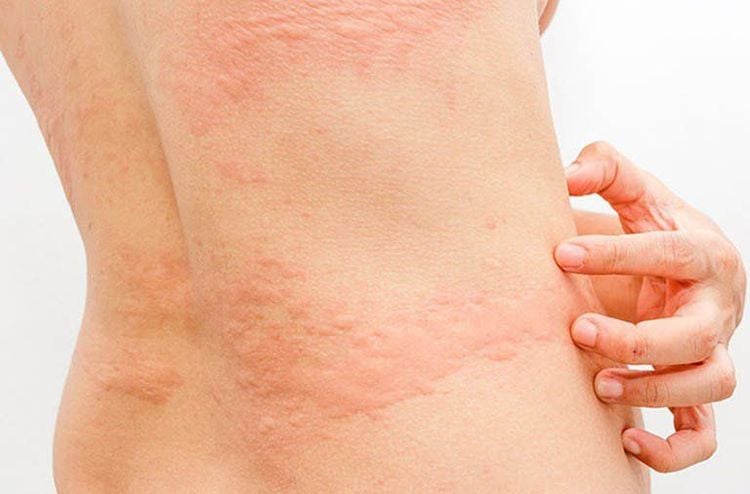This is an automatically translated article.
The article was written by Master, Doctor Ta Que Phuong - Department of General Internal Medicine - Vinmec Times City International General Hospital.Reactions to foods are common and can be divided into two categories as true food allergies and all other reactions. It is important to know the difference between a food allergy and other types of reactions because the treatment of each is different.
1. Food allergy
Food allergies develop when the body's immune system has an abnormal response to one or more proteins in a food. Food allergies can lead to severe or even life-threatening allergic reactions.Other food reactions not caused by the immune system. These reactions cause unpleasant symptoms and are much more common than food allergies. Examples include lactose intolerance, heartburn (gastroesophageal reflux disease), bacterial food poisoning, and sensitivity to caffeine.
2. IgE .-mediated food allergy
In people with "classic" food allergies, the body reacts to proteins in certain foods as foreign or harmful and produces antibodies in response. These antibodies are called immunoglobulin E (IgE) antibodies. Then, when a person is exposed to that food protein again (through food consumption), the food protein binds to IgE antibodies, triggering the release of the chemical. This causes the symptoms of an allergic reaction. This usually happens quickly, within minutes to two hours after eating. A person with a food allergy can also have a "spot reaction" if food touches their skin (hives or rash at the site of contact), even if they don't actually eat it.Sudden onset of symptoms Symptoms of a food allergy can vary from mild to severe or even life-threatening. It is not always possible to predict the severity of symptoms based on symptoms experienced during a previous response. For example, a person may develop mild hives after eating peanuts once and then have a severe anaphylactic reaction after eating peanuts another time. However, the reaction does not necessarily get worse. more after each exposure.
The most common sudden onset of food allergy symptoms include:
Skin - Itching, flushing, hives (itchy bumps, also known as "urticaria") or swelling (angioedema) Eyes - Itchy, watery, red or swollen skin around the eyes Nose and mouth - Sneezing, runny nose, stuffy nose, swollen tongue or metallic taste Lungs and throat - Difficulty getting air in or out, coughing a lot times, chest tightness, wheezing or other sounds with difficulty breathing, increased mucus production, swelling or itching of the throat, hoarseness, voice changes or a feeling of choking Heart and circulation - Dizziness , weakness, fainting, changes in heart rate (fast, slow, or irregular) or low blood pressure Digestive system - Nausea, vomiting, stomach cramps or diarrhea Nervous system - Anxiety, confusion or feeling impending doom Anaphylaxis - is the most severe type of allergic reaction and can cause life-threatening signs and symptoms, including difficulty breathing, swelling of the upper throat and/or tongue, pounding heart very fast or irregular, blood pressure low or cardiac arrest (heart stop). Anaphylaxis usually begins within 5 to 60 minutes of exposure to the trigger (allergen), although, in rare cases, symptoms do not begin until several hours after eat.

Fewer than 10 percent of people develop systemic symptoms due to fruits and vegetables (eg, vomiting or diarrhea), and 1 to 2 percent of people develop systemic anaphylaxis
Common reactions does not occur if the fruit or vegetable is cooked. Tree nuts and peanuts may be an exception because they are associated with a higher risk of serious reactions. If you have a history of an oral allergy to nuts, your allergist may recommend avoiding them in any form (raw, roasted, or cooked) and/or limiting how much you eat at a time. at the time.
Food-dependent exercise-induced anaphylaxis - Some people develop an anaphylactic reaction after eating a certain food and then exercising (within about four hours of consuming the food). ). This is called "food-dependent exercise-induced anaphylaxis." Sometimes a reaction can occur after exercising first and then eating food. In this situation, food does not cause anaphylaxis if the patient is not active. The foods most commonly associated with this condition include wheat, celery, and seafood, although some people react after eating any food and then exercising. Not eating for a few hours before exercise can often prevent this type of reaction.

3. Mixed IgE and non-IgE . food allergens
There are a number of conditions that may be related to food, such as eosinophilic esophagitis (eosinophilic esophagitis) and atopic dermatitis (eczema).Non-IgE Food Allergies It is possible to have a food allergy that is not related to IgE antibodies. With this type of food allergy, symptoms usually develop more slowly and last longer than with a classic (IgE-mediated) food allergy.
The three main types of non-IgE food allergies are:
Food Protein Inflammatory Bowel Syndrome (FPIES) - This is a severe allergy that mainly affects infants; it causes severe digestive symptoms such as vomiting and diarrhea and can also cause low blood pressure. FPIES is usually activated by cow's milk or soy protein, which is found in many infant formulas. It usually goes away on its own after three to five years of age. Food Protein Allergic Proctitis (FPIAP) - This condition affects the lower part of the colon. It can cause rectal bleeding and diarrhea in infants. Celiac Disease and Dystrophic Dermatitis - Celiac disease is a condition in which the immune system reacts abnormally to a protein called gluten, which then leads to damage to the lining of the small intestine. Gluten is found in wheat, rye, barley, and many processed foods. Dermatitis Herpetiformis is a skin condition also associated with gluten sensitivity.
Please dial HOTLINE for more information or register for an appointment HERE. Download MyVinmec app to make appointments faster and to manage your bookings easily.














